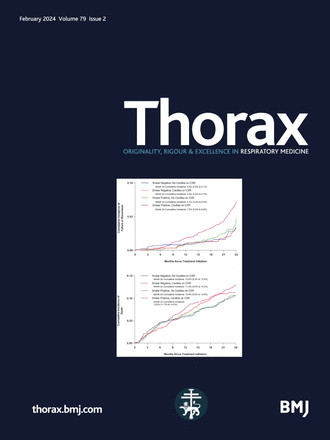Collagen neoepitopes in sarcoidosis: what do they tell us?
IF 9
1区 医学
Q1 RESPIRATORY SYSTEM
引用次数: 0
Abstract
Fibrosis is scarring due to the replacement of tissue architecture by extracellular matrix (ECM), which consists largely of collagen. Scarring progressively destroys organ structure and thereby impairs function. Accumulation of collagen is thought to be due to an increase in production, a reduction in degradation of collagen or a combination of both.1 If so, we might expect the ratio of production to degradation to increase with increasing fibrosis. Biomarkers of type III and VI collagen production (PRO-C3 and PRO-C6) and degradation (C3M and C6M), called neoepitopes, have been developed to measure these processes.1 In diseases such as idiopathic pulmonary fibrosis, where fibrosis is the dominant pathophysiological feature, neoepitope levels align closely with disease progression.2 Whether these collagen markers are relevant in other diseases has been less well explored. In sarcoidosis, fibrosis in affected organs, especially the lungs and heart, accounts for most of the long-term morbidity and mortality that is directly attributable to sarcoidosis itself (rather than due to attempts to treat the disease). Fibrosis in sarcoidosis is thought to occur in the setting of persistent granulomatous inflammation but is likely modulated by other factors besides duration of disease alone since not all patients with chronic sarcoidosis develop substantial fibrosis. A major clinical challenge is to identify whether the dysfunction of an affected organ is predominantly due to granulomatous inflammation or fibrosis. Thus, a blood marker of sarcoidosis fibrosis would be an extremely helpful clinical tool. Recently, Sand and co-workers3 hypothesised that patients with sarcoidosis may have increased plasma levels of collagen neoepitopes and that …肉样瘤病中的胶原新表位:它们能告诉我们什么?
纤维化是由于细胞外基质(ECM)取代了组织结构而形成的瘢痕,细胞外基质主要由胶原蛋白组成。瘢痕会逐渐破坏器官结构,从而损害功能。胶原蛋白的积累被认为是由于胶原蛋白的生成增加、降解减少或两者的共同作用1。1 在特发性肺纤维化等以纤维化为主要病理生理特征的疾病中,新表位水平与疾病的进展密切相关2。在肉样瘤病中,受影响器官(尤其是肺部和心脏)的纤维化是直接归因于肉样瘤病(而非试图治疗疾病)的长期发病率和死亡率的主要原因。肉样瘤病的纤维化被认为是在肉芽肿炎症持续存在的情况下发生的,但除了病程长短之外,还可能受到其他因素的影响,因为并非所有慢性肉样瘤病患者都会出现实质性纤维化。临床面临的一大挑战是如何确定受影响器官的功能障碍主要是由肉芽肿炎症还是纤维化引起的。因此,肉样瘤病纤维化的血液标志物将是一种非常有用的临床工具。最近,桑德和合作者3 假设肉样瘤病患者的血浆中胶原新表位水平可能会升高,并且...
本文章由计算机程序翻译,如有差异,请以英文原文为准。
求助全文
约1分钟内获得全文
求助全文
来源期刊

Thorax
医学-呼吸系统
CiteScore
16.10
自引率
2.00%
发文量
197
审稿时长
1 months
期刊介绍:
Thorax stands as one of the premier respiratory medicine journals globally, featuring clinical and experimental research articles spanning respiratory medicine, pediatrics, immunology, pharmacology, pathology, and surgery. The journal's mission is to publish noteworthy advancements in scientific understanding that are poised to influence clinical practice significantly. This encompasses articles delving into basic and translational mechanisms applicable to clinical material, covering areas such as cell and molecular biology, genetics, epidemiology, and immunology.
 求助内容:
求助内容: 应助结果提醒方式:
应助结果提醒方式:


